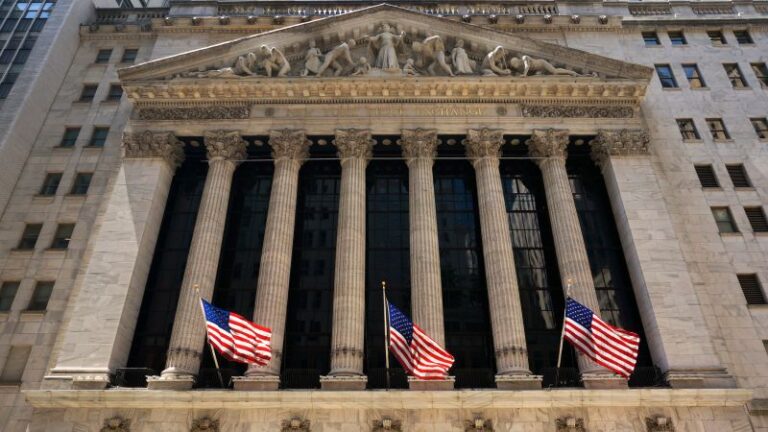[ad_1]
A version of this article first appeared in CNN Business' Before the Bell newsletter.Not a subscriber? You can sign up here it is. You can listen to the audio version of the newsletter by clicking on the same link.
new york
CNN
—
Stocks of companies that offer stable payouts could return to investors' favor this year.
Dividend stocks fell out of favor in 2023, even as all three major U.S. indexes weathered regional banking turmoil, high interest rates and geopolitical tensions to post double-digit returns.
As interest rates rose to a 22-year high, investors preferred bonds with attractive yields over riskier stocks with smaller dividends. Artificial intelligence hype also drove investors into mega-cap tech stocks, while the rest of the market lagged.
The S&P 500 Dividend Aristocrats Index, which measures the performance of companies that have increased their dividends over the past 25 years, rose 5.7% last year, compared with a 26% rise in the S&P 500 Total Return Index.
This is a reversal from 2022, when the dividend index outperformed the benchmark total return index as investors fearful of Federal Reserve interest rate hikes sought high-income stock havens.
Some traders think dividend stocks could make a comeback this year. Yields will fall sharply in the second half of 2023, and could continue to fall if the Fed cuts rates.
“Investors are looking for sustainable, high-yield dividends as market volatility is expected to continue through the easing cycle,” Morgan Stanley strategists said in a note Monday.
Larry Adam, chief investment officer at Raymond James, prefers dividend stocks in sectors such as tech and health care because of their growth potential, over traditionally defensive categories such as utilities. He says his company only invests in dividend stocks with a growth component.
“We're not only looking for a high reputation, but also the ability to maintain it,” Adam said.
Investors tend to reward companies when they raise their dividends. Lennar shares are up more than 6% this week after the homebuilder on Tuesday raised its annual dividend to $2 a share from $1.50 and increased stock buybacks by $5 billion.
Mastercard announced on Dec. 5 that its board of directors has approved an increase in its quarterly dividend from 57 cents to 66 cents per share and a stock buyback plan of up to $11 billion. Mastercard stock has since risen about 5%.
Morgan Stanley data dating back to 2014 shows that companies in the Russell 1000 index that increased their dividends outperformed by an average of 3.1% in the six months following the announcement. Companies that cut their dividends outperformed their stock prices. His performance over the same period was 4.7% lower.
Of course, bond yields are unlikely to decline smoothly.Yields have risen slightly since the beginning of the month, contributing to remittances Stocks are falling and the market could continue to see some volatility this year as investors readjust their interest rate expectations.
According to the CME FedWatch tool, Wall Street currently expects the Fed to cut rates seven times this year, but the central bank has only cut rates three times so far.
The Federal Reserve's preferred measure of inflation, the Personal Consumption Expenditures Price Index, measured an annual rate of 2.6% in November. So getting that number down to the Fed's goal of 2% should happen quickly, right?
It may not be that simple, reports my colleague Elisabeth Buchwald.
Fed officials expect it will take another two years to reach a solid 2%, according to the Fed's latest summary of economic forecasts.
In many ways, bringing inflation down from its peak was easy. In fact, many economists say it may not even have been necessary to raise interest rates to their highest levels in 22 years to achieve that goal. Much of the rise in inflation is due to supply chain disruptions and an unusual surge in demand caused by the pandemic.
“If you print $3 trillion in new money and give it to people, you get inflation, and that's exactly what happened,” said John Cochran, a senior fellow at the Hoover Institution. “But once that money is spent, inflation naturally slows down. That's pretty much what happened here.”
read more
Mortgage rates rose for the second week in a row this week, but are still more than 1 percentage point below last year's highs, my colleague Anna Barney reports.
The average interest rate on a 30-year fixed-rate mortgage was 6.66% for the week ending Jan. 11, up from 6.62% the previous week, according to data released Thursday by Freddie Mac. A year ago, the average 30-year fixed rate was 6.33%.
Despite the past two weeks of gains, the movement in mortgage rates is smaller than during the nine-week decline at the end of 2023 and still more than a percentage point below last year's high of 7.79%. This continues to bring affordability improvements to homebuyers who have struggled in one of the most affordable markets in recent decades.
“Mortgage rates have not moved significantly over the past three weeks, remaining in the mid-6% range, which has slightly increased demand among homebuyers,” Sam Cater, chief economist at Freddie Mac, said in a statement. Ta.
But even this slight increase in demand, combined with still-tight inventories, continues to drive prices up faster than incomes, he added.
Please see here for the detail.
[ad_2]
Source link


